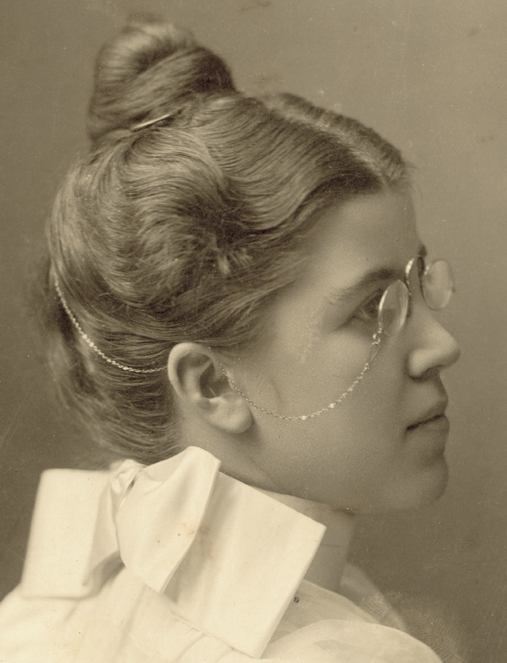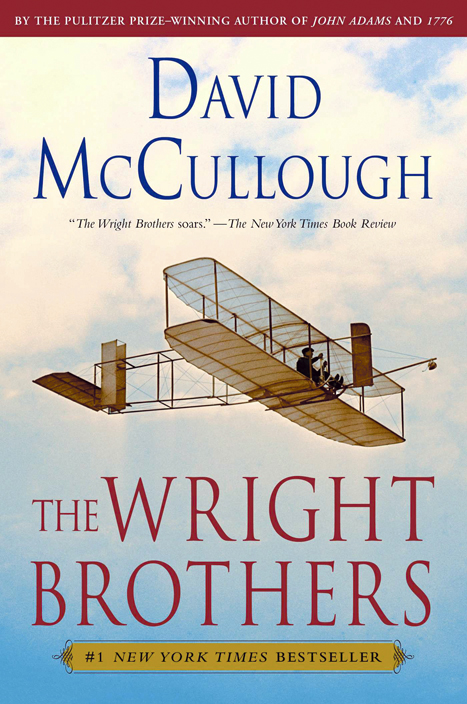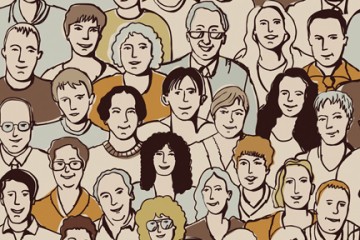Writer to right passage on Wright’s wrong

David McCullough weighs in on Katharine’s antisemitic expressions
By Marshall Weiss, The Dayton Jewish Observer
Now in its 13th year, The Big Read is an inspired concept. A collaboration of numerous public libraries, colleges, and a bookstore in the Dayton region, The Big Read asks the public to vote on a title each year to “bring people together to read and talk about the same book.”
This year’s choice is close to the hearts of Daytonians: The Wright Brothers, by one of America’s most celebrated authors of history, David McCullough. Between March 12 and April 16 — the 150th anniversary of Wilbur Wright’s birth — Big Read libraries will host discussions and programs about McCullough’s 2015 New York Times #1 bestseller.
When I read the book last year, one passage gave me much concern. It’s about Katharine Wright, Orville and Wilbur’s sister. She was essentially the glue that held the family together after the death of their mother in 1889.
McCullough celebrates Katharine’s role in her brothers’ successes. And he doesn’t shy away from the antisemitism Katharine expressed toward the Wrights’ sales agent in Europe, Hart Berg of Flint & Co. In a 1907 letter to Wilbur, Katharine seems emotionally out of sorts. She’s impatient with Berg’s progress and the back-and-forth terms of Flint & Co.’s commission structure. The way McCullough explains Katharine’s antisemitism in the letter stopped me cold:

“She had had little or no experience with Jews, but having seen a photograph of Hart Berg, she wondered if he might be one. ‘I can’t stand Berg’s looks,’ she wrote. ‘It has just dawned on me that the whole company is composed of Jews. Berg certainly looks it.’”
I was familiar with this letter; that wasn’t the surprise. My concern was that readers — Jewish and non-Jewish, here and elsewhere — could come away thinking there was no Jewish community in the Dayton of that time period.
McCullough’s explanation also gives the impression that her antisemitism couldn’t have been grounded in her personal experiences encountering Jews. If there was no Jewish population here, her antisemitism was an abstraction, and maybe she couldn’t be held accountable. But we know that Dayton had a Jewish community of at least 3,000 in those days.
These were my thoughts when I reached out to the author a few weeks ago.
Full disclosure: I’m a David McCullough fan. Could my hero have made an honest-to-goodness mistake? Is it possible that McCullough had fallen in love with Katharine in his research and felt the need to protect her? And how do I gently present the facts to the venerated author in a way that shows I mean no ill will, but only hope to set the record straight?
I first learned of The Wrights’ Jewish connections in 2002 when a representative of the Israeli Postal Authority called me. In 2003, to commemorate the centennial of powered flight, the Israeli Postal Authority hoped to issue a series of stamps featuring the Wright brothers. But first, the authority wanted to ensure that Orville and Wilbur weren’t antisemites like Thomas Edison and Henry Ford. Their question for me: were the Wright brothers antisemites?

They were not. In my research, I could find no documentation of antisemitic expression from either of the Wright brothers.
Always in search of a Jewish angle, I started to wonder what Jewish connections The Observer could write about during the centennial of flight. I asked local history buff Bob Thum to see if he could find any Jewish connections to the Wright brothers.
We were pleasantly surprised when he rediscovered that one of the Wright’s first flight school instructors and exhibition pilots, Arthur L. Welsh, was not only Jewish but an ardent Zionist. Bob wrote the story for The Observer, and I was pleased to report back to Israel’s postal authority all of the good news. In 2003, the postal authority issued three Wright brothers stamps.

Bob’s research also gave me a more nuanced insight into Katharine’s experience with Jews. Welsh, the first-known Jewish airplane pilot, was killed in a crash testing a Wright plane for the Army at College Park, Md. on June 11, 1912.
Although this was only two weeks after Wilbur’s death of typhoid fever, Katharine and Orville attended Welsh’s funeral at an Orthodox synagogue in Washington, D.C. on June 13.
An account in the Yiddish Forward indicated, “All present were in tears, including Mr. Orville Wright and his sister, who were doing all they could to console the mother and wife of the deceased.”
Even so, in the meticulously researched 2009 book Orville’s Aviators, John Carver Edwards notes that in a June 15 letter to her father, Katharine wrote of the Welsh funeral, “All of his family and his wife’s family show their Jewish traits much more than Mr. Welsh did…”
My sense is that Katharine was what one might call a “parlor antisemite.” She was a product of her time. I suspect she picked up the antisemitism habit while she was an undergraduate at Oberlin College in the 1890s.
Though it’s almost certain she wouldn’t have socialized with Jews, there’s no doubt that Katharine would have encountered Jews regularly when she was downtown for her work at Steele High School, where she taught Latin, and on outings.
In 1907 (the year of the letter about Berg), Dayton’s more established German Jews had lived downtown for two generations. They tended to be merchants and attended the Reform B’nai Yeshurun, later renamed Temple Israel. The more recently-arrived Eastern European Jews lived in the area around Wayne Avenue and Wyoming Street and prayed at Beth Jacob and Beth Abraham. At first, these less-educated Jews often lived in poverty.
Katharine taught at Steele High School beginning in 1898 and in that first decade of the 1900s. From 1894 to 1906, Steele was Dayton’s only public high school. Unless they dropped out, this is where all of Dayton’s Jewish teens would have attended high school in that time period.
If she ever did her “marketing” downtown, Katharine would have encountered Jews selling produce. If she ever went to Miami Valley Hospital, a Protestant institution, she would have encountered Jews who populated the neighborhood surrounding it who were treated there.
These were the main points I sent to David McCullough in an email. Along with a request: “If this is an honest-to-goodness error, is this something that might be corrected in subsequent editions?”
“I very much appreciate your letter,” McCullough told me on the phone a week later. “I have checked with my publisher, and there’s no problem about revising that sentence to that paragraph. It’s not going to happen very soon because they’re not going back for another printing for probably another several months.”
It’s not often that I’m starstruck when I’m in interview mode. On this call, I was fighting back the fanboy urge.
“But I think the points you raised were obviously very valid, and instead of saying that she had had little or no experience, I think the clearest thing is that she had not had a lot of experience,” McCullough said.

He said that in his research for The Wright Brothers he had read more than 1,000 Wright family letters and found “no reference ever to any attitude toward Jews” from anyone else in the family.
“But I don’t recall ever reading any name, in what limited social life they had, that sounded the least bit Jewish or what was clearly Jewish,” McCullough added. “But none of us like to make mistakes, I think that was a mistake. I should have known better than that, but as you know, in that day and age, there was a lot less social intermingling after hours.”
He described the Wrights as “quite reclusive in how they treated most everybody, not just people with a different religion. I would guess that if I were to count the number of people they saw on a social basis, it would probably be less than eight, if that.”
McCullough also made the point that he has been fighting antisemitism since he was a gradeschooler in Pittsburgh, “when some of my classmates would pick on somebody because they were Jewish. And I am outraged by it, always have been.”
For those from large cities with sizable Jewish populations, it doesn’t always register that we Jews have made our way even to the smallest towns in search of the American dream. It’s almost like that iconic Saul Steinberg New Yorker cover showing a vast wasteland west of the Hudson all the way to the Pacific. I remember when I first started the Jewish paper here, my mother, laying on her Northeast Philadelphia dialect questioned, “There are Jews in Dayton?”
And so, as a sort of Horton The Elephant on behalf of Dayton’s Jews of the Wright brothers era, I hear them shouting, “We are here! We are here! We are here!” Because a community’s a community, no matter how small.
Marshall Weiss is editor and publisher of The Dayton Jewish Observer. He is writing a book about the history of Jewish Dayton, to be published in 2018.
To read the complete March 2017 Dayton Jewish Observer, click here.


